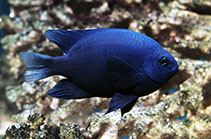| Family: |
Pomacentridae (Damselfishes), subfamily: Pomacentrinae |
| Max. size: |
18 cm TL (male/unsexed) |
| Environment: |
reef-associated; marine; depth range 1 - 12 m, non-migratory |
| Distribution: |
Indo-West Pacific: Red Sea and East Africa to the Indo-Malayan Archipelago, Philippines, Taiwan, Ryukyu Islands, Palau, New Guinea, Solomon Islands, Vanuatu, and northern Australia. |
| Diagnosis: |
Dorsal spines (total): 13-13; Dorsal soft rays (total): 13-15; Anal spines: 2-2; Anal soft rays: 12-15. Description: Adult stage is uniformly deep-blue black including all fins (Ref. 48636, 90102). Juvenile body pale blue, anterodorsal contour with broad yellow zone from snout to dorsal fin, caudal fin margin yellow. Transformation from colorful juvenile to uniformly black adult stage occurs at a size of 50 to 60 mm (Ref. 37816). Body depth 1.7-2.0 in SL (Ref. 90102). |
| Biology: |
Adults are found in coral-rich areas of lagoon and seaward reefs and usually associated with soft corals on which it feeds (Ref. 1602, 58652). Occur singly or in pairs (Ref. 1602). Juveniles are encountered in around staghorn Acropora corals (Ref. 1602). Adults often near Tridacna clams and may feed on their feces (Ref. 9710). Oviparous, distinct pairing during breeding (Ref. 205). Eggs are demersal and adhere to the substrate (Ref. 205). Males guard and aerate the eggs (Ref. 205). Diurnal species (Ref. 113699). |
| IUCN Red List Status: |
Least Concern (LC); Date assessed: 23 September 2021 Ref. (130435)
|
| Threat to humans: |
harmless |
Source and more info: www.fishbase.org. For personal, classroom, and other internal use only. Not for publication.
